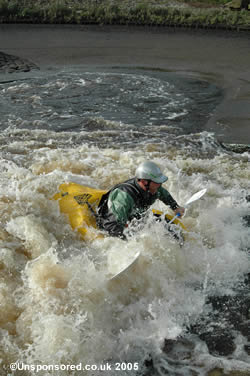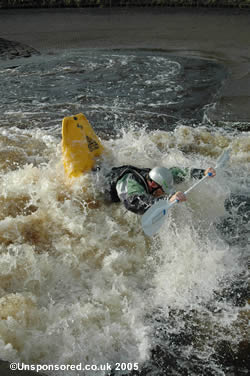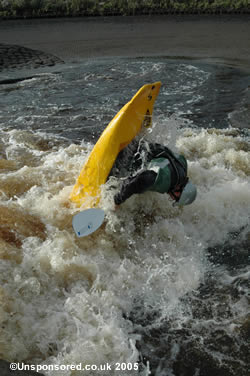A loop is one of these re-discovered moves that has caught the imagination of paddlers and kayak designers the world over. If you imagine a cartwheel in in hole but with no edging of the kayak involved. The kayak cartwheels (loops) end over end with the bow ploughing under the water and throwning the paddler upside down. As this happens the stern of the now upside down boat gets caught by the on coming water resulting in the paddler ending up right on the wave!!
Small boats with plenty of volume help, as does the addition of an overthruster. This prevents volume being lost due to the spraydeck being pushed inside of the kayak. In addition it also prevents the deck imploding which would probably result in a “technical swim”!
Pick a hole that is deep enough to pull the move in. The last thing you need is finding yourself being driven into the river bed. If the stopper has a high pile then this will also make the move easier to initiate.
The move simply entails getting the boat into the air. The greater the gap between the kayak and water during the loop sequence the greater your chances of securing a successful move.
Getting the front of the kayak to plough under the water is childs play, getting the following end requires good timing and good technique. Imagine your sitting on top of the pile of a resonably large, deep and rententive hole. You slowly get drawn upstream by the recirculating water and you lean forward to get the nose of the boat deep into the oncoming flow.
As the nose drops stand up then quickly tuck yourself forward to throw the stern of the boat right over your end, this if done correctly will give your boat some “pop” and throw the stern of the boat cleanly into the oncoming water.
As the boat come over your head and you enter the water stay tucked. Keeping in a forward position as the wave will help push the stern beneath you leaving you upright on top of the wave. In theory! Quite often as the stern hits the oncoming water the boat will loose its orientation resulting in the boat being skewed over to one side or the other.






Leave a Reply